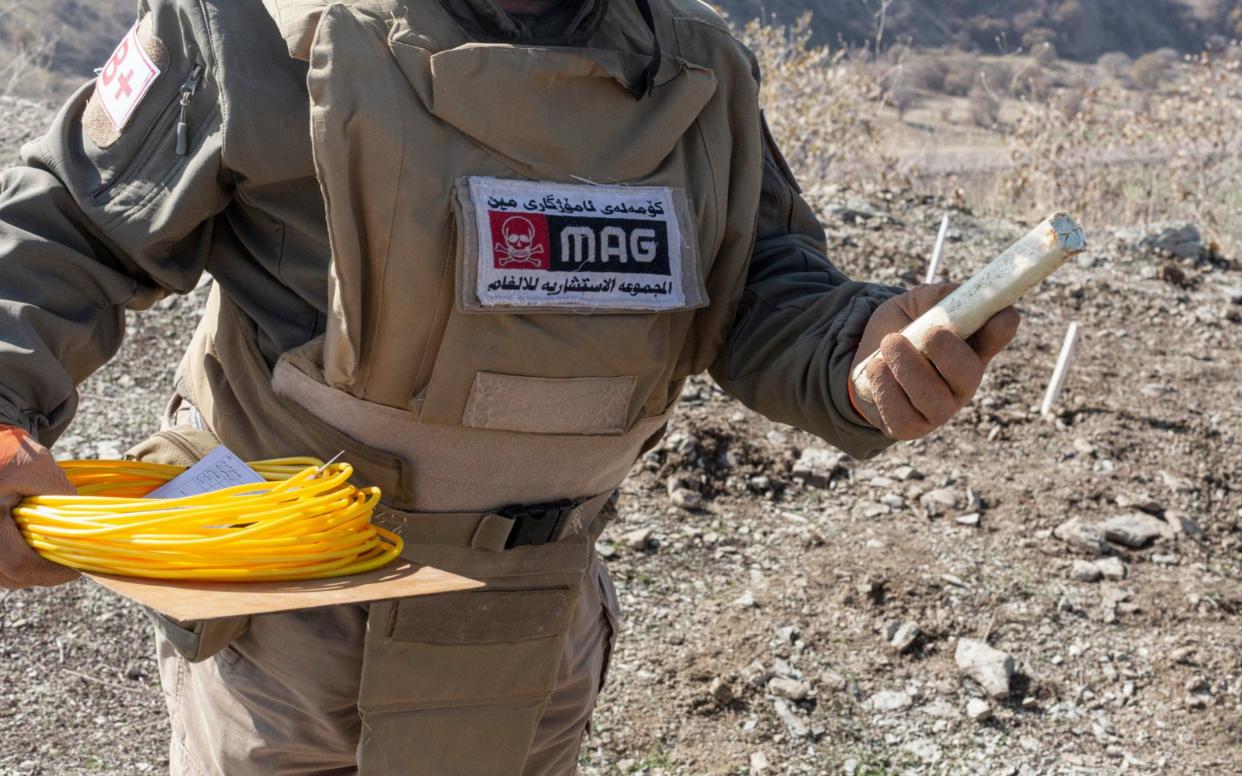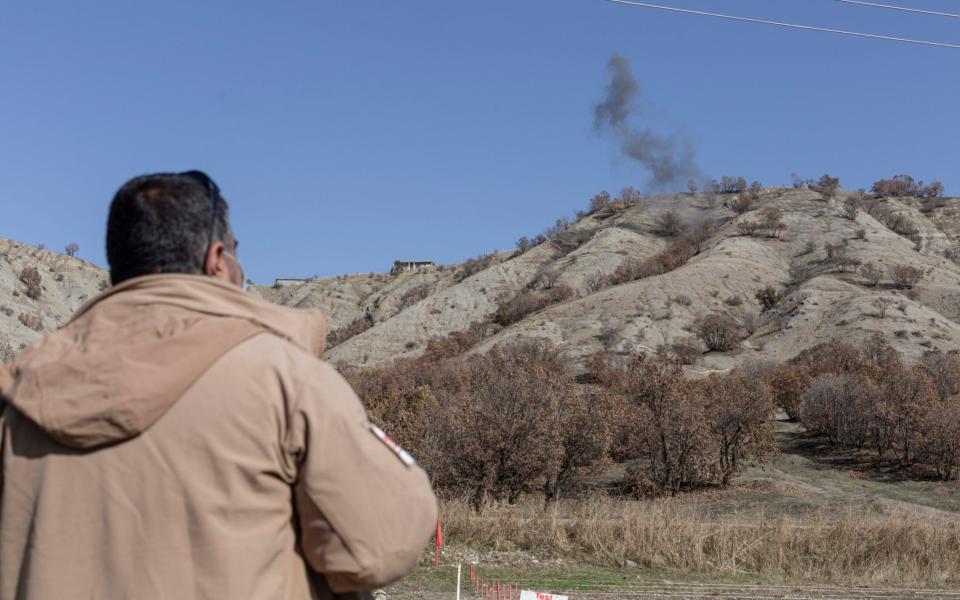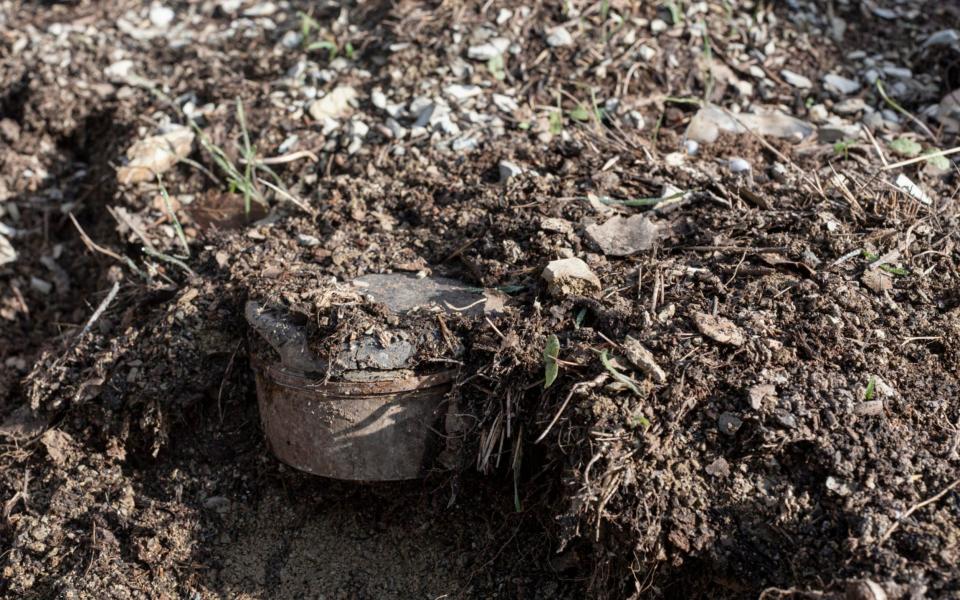Saddam's deadly legacy: 40 years after war with Iran, border area is still littered with landmines

At first glance, the Mawat district of north-east Iraq is a rustic idyll, a belt of rolling hills lined with olive and fruit groves. But on closer inspection - as many visitors have learned the hard way - it is full of hidden dangers.
What looks like a Middle Eastern Tuscany was once on the frontline of Iraq's eight-year war with Iran, where Saddam Hussein's army planted vast quantities of land mines. Lurking in its gulleys and orchards are countless Russian and Italian anti-personnel devices - all still lethal.
Today, despite nearly 30 years of mine clearance work, more than half remain - a glaring reminder of the scale of the so-called "legacy mine" threat in former warzones.
"We get a lot of requests from mayors and villagers around here to clear the area," says Jabar Fatih Mahmoud, 49, an Iraqi employee of the Mines Advisory Group, the British charity, as he showed The Telegraph around a minefield listed on his clearance map as 'Kalka Shenka 2C'.
"But this region is also popular with picnickers, and not everyone knows the mines are here."
The minefields in Mawat and the surrounding governorate of Sulaymaniyah are a grim example of how such weapons are used not just for military purposes, but to actively punish civilian populations.

The area is a heartland of Iraq's Kurdish population, whose forces sided with Iran during the 1980-88 war. When local Kurds returned to the area afterwards, they found Saddam's forces had sown it with far more mines than were needed simply for defensive purposes.
The soldiers also left no warning signs and kept no maps of where the mines had been laid, according to MAG's founder Rae McGrath, who first assessed the area in 1992.
In a report at the time for Human Rights Watch, Mr McGrath, an ex-British Army engineer, said: "It is a reasonable conclusion that the Iraqi army laid and abandoned these millions of mines to make large areas of Kurdistan unusable for all time."
In the years since, legacy landmines in Sulaymaniyah and elsewhere in Iraq have killed and injured at least 8,000 people, around a quarter of them children, according to UN figures.
MAG, which has 750 staff in Iraq, does aim to clear them all eventually, but it is a task measured in decades, not years. In Sulaymaniyah alone, there are 208 square kilometres of mine-contaminated land. That is nearly ten times the area contaminated during the 1982 war in the Falklands, which were finally declared landmine-free last month.
In Sulaymaniyah, only 81 square kilometres has so far been cleared - although even that figure seems impressive when one sees first-hand how painstaking the clearance procedure has to be.

It is done one square metre at a time, either by MAG staff using hand-held detector devices, or by dogs trained to smell vapour from explosives. A staff member can clear at most 100 metres per day, while a dog can clear around 600, although whenever a mine is found, the procedures become even slower.
On the day of our visit, for example, the staff have located four Russian-made PMN-mines - dark-coloured palm-sized discs that are barely visible in the soil around them. One is buried in the soft earth of a steep gulley, large piles of which must be excavated first in order to get at it safely.
Nicknamed the "Black Widow" because of its dark colour, the PMN typefies the calculated brutality of landmine design. It contains around five times the amount of explosive found in normal anti-personnel mines, meaning victims are likely to lose not just a foot but their entire leg, or be killed outright.
Another common mine here is the Italian Valmara 69, a hedgehog-shaped device with spikes that act as triggers. Based on the German-made "Bouncing Betty" design used in World War II, the initial charge propels the mine half a metre into the air, where it then detonates a horizontal shrapnel blast that can kill anyone in a 25-metre radius.
Nine million Valmaras were sold to Iraq during the 1980s despite an arms embargo, leading to the jailing in 1991 of seven executives from Valsella, the firm that made them.
Mindful of the dangers they face, the clearance teams always work with medics on hand, with distances and driving times to the nearest hospitals kept handy. Mr Mahmoud himself nearly came to grief in 1994, when he and a colleague unwittingly strayed into a field of Chinese-made plastic mines - designed to be difficult to spot using metal detectors.

"My colleague set one off behind me that I had already walked over and just missed," he said. "There was an enormous bang, with a flash and smoke, and I found myself covered in my colleague's blood and skin. At first I couldn't tell if it was a dream or just reality."
Realising he was surrounded by mines, Mr Mahmoud had to stay where he was while others rescued him and his injured companion, who survived. It did not deter Mr Mahmoud from continuing to his devote his life to mine clearance, although such is the scale of the task that he may not see it completed in his lifetime.
According to the Landmine Monitor data base, Iraq is the most landmined country on the planet, with around 650 square kilometres of mine-contaminated land. Another 200 square kilometres have been contaminated in recent years by Isis bombs and booby traps.
The task in Iraq, in turn, is dwarfed by the clearance challenge worldwide. Globally, there are now an estimated 25,000 square kilometres of contaminated land - an area larger than Wales.
And while 164 of the world's 193 countries are now parties to the Ottawa Treaty banning anti-personnel mines - backed the late Princess Diana - new minefields are still springing up, often planted by insurgents in the likes of Afghanistan, Nigeria and Somalia.
Mr McGrath, MAG's founder, believes the problem can only be dealt with by a "huge and sustained injection of funding from the international community."
He said: "I’m proud of the progress MAG and others have made over the last three decades, but I have to admit that I sometimes despair at how much there is still to do, and how many lives are still impacted by the issue.”
MAG carries out landmine clearance worldwide. You can donate to them here

